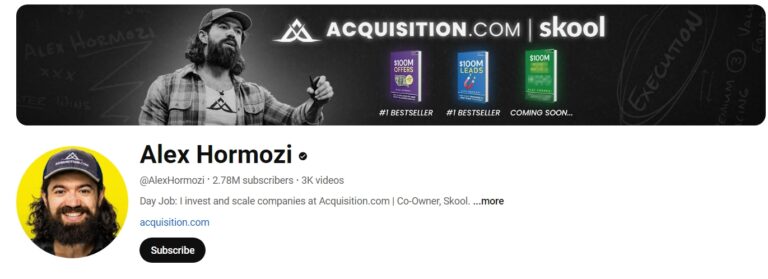Top 17 Business Scaling Strategies: Expert Advice on Pricing, Advertising, and Sales
Alex Hormozi
Alex Hormozi is a highly successful entrepreneur and investor, known for his exceptional ability to scale companies and deliver transformative business growth. As a co-owner of Acquisition.com, Alex has made…
Key Take-aways
- Anchor Pricing: Introduce a high-priced product to create a price anchor for your core offers.
- Increase Advertising: Most people won’t know you exist without aggressive and consistent advertising.
- Focus on One Channel: When scaling under $1M, focus on one channel, one avatar, and one product.
- Start for Free: Offering a free service can help you build testimonials and trust when starting.
- Raise Prices: Raising your prices may reduce sales, but it can significantly increase profit margins.
- Proof Over Promise: Leverage testimonials and recent proof to sell more effectively than promises alone.
- Talk to Customers: Speaking with customers frequently can solve advertising, pricing, and product issues.
- 10x What Works: Before trying new strategies, 10x the efforts that are already working.
- Selling Sawdust: Identify ways to monetize the excess capacity in your business.
- Three Legs to Business: Focus on acquisition, delivery, and operations as the pillars of your business.
- Growth is Stressful: Accept that stress is part of growth, stagnation, and even decline.
In today’s fast-paced business environment, knowing how to scale your business can make the difference between success and failure. Whether you’re building a startup or already running a multimillion-dollar enterprise, there are fundamental strategies that can help you grow while maintaining profitability. In this article, we’ll break down the top 17 business scaling strategies to ensure your business thrives.
1. Anchor Pricing: A Powerful Sales Tactic
Introducing a high-ticket item to your product or service lineup can drastically affect how potential customers perceive your core offer. By adding an offer that’s 10 or even 100 times more expensive than your main product, you establish a price anchor. This makes your core offering seem much more reasonable in comparison. For example, one entrepreneur tripled his profits overnight by offering a higher-priced version of his original product, which led to a surprising increase in sales of the more expensive option.
2. Advertise Relentlessly
No one knows you exist until you make it known. Even if you feel like you’re advertising too much, the reality is that people often aren’t paying attention. One entrepreneur found that despite heavy advertising, only one person in his large audience knew about his upcoming book launch. Take the lesson from Henry Ford: You may be sick of your own ads long before your potential customers even remember your name. Increase your advertising on all available channels to ensure you reach your target audience.
3. Focus on One Channel, Avatar, and Product
When your business is generating less than $1M in revenue, focus all your efforts on one acquisition channel, one target avatar, and one core product. Many entrepreneurs make the mistake of diversifying too soon, which leads to scattered efforts and suboptimal results. By narrowing your focus, you can create a product that truly meets the needs of a specific customer base and scale effectively.
4. Start for Free to Build Trust
Offering free services early on can provide you with the testimonials and proof you need to scale your business. This not only gives you confidence in your product but also builds trust with customers. Even large companies benefit from starting new products or services for free to collect valuable feedback and improve their offerings.
5. Raise Prices to Increase Profitability
Raising your prices can be a nerve-wracking decision, but it almost always leads to increased profitability. One business saw a 35% reduction in conversion rates after doubling its prices, but profits tripled due to the higher margins. The key is to be bold and understand that pricing is often more inelastic than you think. Fewer customers at a higher price can still mean higher profits with lower costs.
6. Proof Over Promise
Instead of relying on promises to sell your product, focus on proof. Use recent testimonials, visuals, and evidence to demonstrate your product’s effectiveness. 1000 testimonials will always be more convincing than a promise of results. Gather proof in the form of reviews, customer feedback, and case studies.
7. Talk to Your Customers
Customer feedback is one of the most valuable tools for improving your product, pricing, and advertising. Talking to customers can provide insights that you may not have considered, and help solve issues with conversion or customer satisfaction. Engage with your customers regularly to get feedback on what’s working and what isn’t.
8. 10x What Works
Before you try something new, make sure you’re maximizing the strategies that are already delivering results. Focus on 10x-ing what works in your business before you start experimenting with new channels or approaches.
9. Selling Sawdust: Monetize Your Excess Capacity
Every business has untapped potential or excess capacity. Look for ways to leverage existing resources or assets that can be repurposed or monetized. This strategy, often referred to as selling sawdust, can create new revenue streams with little additional cost.
10. Three Legs of Business: Acquisition, Delivery, and Operations
A successful business is built on three key functions: acquisition, delivery, and operations. Acquisition is about getting customers, delivery is about meeting or exceeding their expectations, and operations ensure the smooth running of your business. Focus on these three pillars to scale effectively.
11. Growth is Stressful, Stagnation is Stressful
Stress is an unavoidable part of running a business, whether you’re growing, stagnating, or declining. The key is to recognize that stress is normal and not a sign that something is wrong. Embrace the challenges and understand that they are part of the entrepreneurial journey.
12. Raise Prices Yearly to Keep Up with Inflation
If you haven’t raised your prices in several years, you’re likely losing profit. Inflation gradually erodes the value of your revenue, and **raising prices** by at least **3% to 6% annually** can help you stay ahead of rising costs.
13. Focus on Customers’ Pain Points
To improve your conversion rates, **highlight the pain points** of your customers and show how your product or service solves them. Customers are more likely to convert when they feel understood and see that your solution directly addresses their concerns.
14. Long Billing Cycles Reduce Churn
Consider **extending your billing cycles** to reduce customer churn. Offering yearly payment plans rather than monthly ones gives customers a longer period to experience the value of your product before reconsidering their purchase decision.
15. Unify Sales and Advertising
Instead of treating **sales and advertising** as separate functions, integrate them under one leadership team. **Sales and marketing** should work together to ensure consistent messaging and efficient conversion. This eliminates departmental friction and increases overall effectiveness.
16. Hire People Who Raise the Bar
Every new hire should **raise the average standard** of your team. Avoid hiring just to fill a role—hire people who bring something new to the table and improve the overall performance of the team.
17. The Person with the Highest Standards Should Lead
In every department, the person with the **highest standards** should be the one in charge. High standards ensure that quality is maintained and that the team performs at its best.

